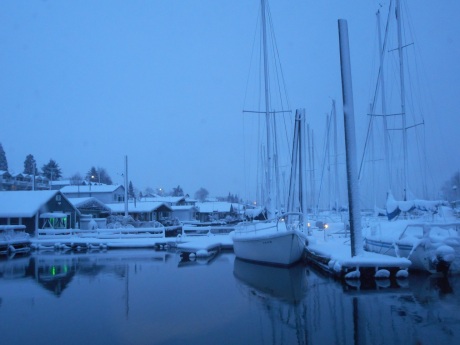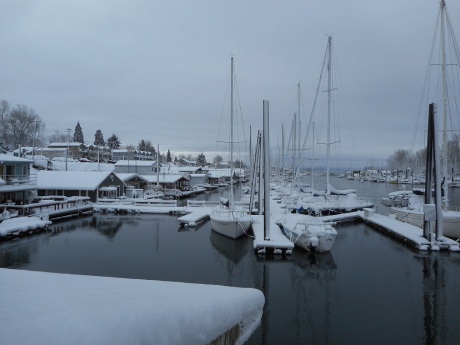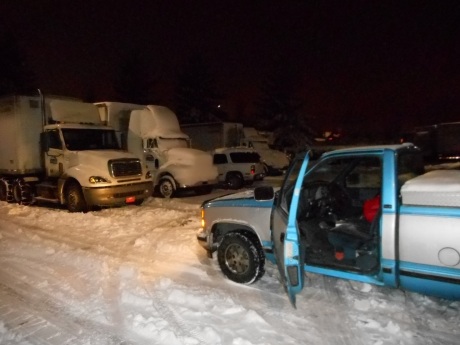Snowstorm Reflections on Collapse and Recovery
15 January 2017
Sunday

Early in the history of this blog I wrote about a snowstorm in Portland during December 2008, Snow in Portland, More Snow, and Lessons from a Snowstorm, and now Portland has had another uncharacteristically heavy snowfall eight years on. I am always fascinated to watch the rapidly changing behaviors of the population of a city as it responds to rapidly changing conditions, and I can’t help but extrapolate from these observations to other disruptions to the ordinary business of life.

The initial impact of a big snowstorm (in a temperate climate where snowstorms are infrequent) is chaos and frantic activity. After the initial chaos, the city goes quiet, and driving around a city after it has gone quiet gives an apocalyptic feeling, as though the end of the world has come. A snowstorm is, in miniature, the collapse of a complex society, such as Joseph Tainter wrote about:
“Collapse, as viewed in the present work, is a political process. It may, and often does, have consequences in such areas as economics, art, and literature, but it is fundamentally a matter of the sociopolitical sphere. A society has collapsed when it displays a rapid, significant loss of an established level of sociopolitical complexity. The term ‘established level’ is important. To qualify as an instance of collapse a society must have been at, or developing toward, a level of complexity for more than one or two generations. The demise of the Carolingian Empire, thus, is not a case of collapse — merely an unsuccessful attempt at empire building. The collapse, in turn, must be rapid — taking no more than a few decades — and must entail a substantial loss of sociopolitical structure. Losses that are less severe, or take longer to occur, are to be considered cases of weakness and decline.”
Joseph A. Tainter, The Collapse of Complex Societies, Cambridge: Cambridge University Press, 1988, p. 4
Of course, the collapse precipitated by a snowstorm is not a political collapse, but it is a rapid and significant loss of an established level of complexity, and a temporary return to a simpler way of life.

When someone abandons their car and walks away, eventually walking around their neighborhood rather than driving, this is a significant simplification of life, and the simplest level to which life can be reduced is that of mere survival, or perhaps I should say subsistence. Because the conditions of a snowstorm or a flood or some similar disruption (say, a power outage) are temporary it does not force a return to subsistence agriculture, but there are occasions when one finds oneself no longer concerned by the technical details of one’s work, and one is only fighting to stay alive, as all other considerations are thrust aside in order to deal with the immediacy of the circumstances. However, it is easy to imagine (especially with the looming specter of climate change) that a storm could be the first disruption in a series of escalating disruptions that could force society to abandon its complex institutions and way of life, returning to subsistence agriculture, or even nomadic hunting and gathering. If a large flood failed to recede after a few days because water levels had crept higher, the disruption of the the storm that caused the flood would be a mere foretaste of things to come.

There is a great deal of social momentum behind the ordinary business of life, and one can observe that people continue to go about their routines in the routine way for as along as possible — right up the moment when it becomes actually physically impossible to continue to going about things as usual. Thus one sees people setting out for work as usual even as the snow is beginning to fall, and as the snow piles up they try to continue to go about their business. It is only when, on the drive home, their car will not move forward another inch, when they abandon it and walk away. As long as a choice remains, most will choose to continue with the ordinary business of life; the routine is only abandoned when no choice remains and one is forced by circumstances to alter one’s behavior.

There is also a strong desire to return to normalcy after the disruption of a storm, so that at the first sign of conditions improving, people head out again in large numbers. In the case of the snowstorms I have seen in my years, this creates a problem because the main roads will be cleared of snow, but the secondary roads and parking lots are still icy, and many people over-confidently driving at full speed on the highways cause problems for themselves and others. The desire for the return to normalcy is a desire for the familiar normalcy, the old normal, while the conditions of the storm, strange and unfamiliar at first, dictate a new normal, and there is a tension between the old normal and the new normal as society attempt to adjust and compensate for changed conditions. As long as the conditions of the new normal are temporary, the old normal will return, but the longer the conditions persist, the longer the new normal persists, and, as the phrase implies, the new normal eventually becomes familiar if it endures for a sufficient period of time.

I imagine that in the case of the true collapse of societies, and not merely an ephemeral collapse precipitated by a weather event, that this desire to return to normalcy results in a lot of false starts, like commuters returning to the roads too soon after a snowstorm. There are probably many hopeful moments in the collapse of a society when people come out of their hiding places and venture out into the world again, hoping that they can return to their routines. When Sarajevo was under siege during the Balkan wars of the 90s, it was several years before life could return to normal. Similarly, when the First and Second World Wars began, it would be several years before normalcy would return.

When a society well and truly collapses, never to rise again, one can imagine for years or for decades people looked for a return to normalcy that would never come. Or if life seemed to return to normal for a time — for weeks or months or years — it was only a deceptive return to old ways that would soon disappear forever. When Roman cities in the west began to fail, there was probably a movement like the ebb and flow of the tide, when people would abandon their city, then go back, then abandon it again. Each time those who returned would be fewer in number, there would be fewer shops open, and fewer goods for sale, and there might be increasing lengths of time between abandonment and return, until eventually the period of abandonment stretched into years, and the city fell into disrepair, fit only for looting from the ruins.
. . . . .
. . . . .
. . . . .
. . . . .
Counterfactuals in Planetary History
3 June 2016
Friday
Since the end of the Cold War, the global political and economic order established at the end of the Second World War has been unraveling, sometimes slowly, sometimes with shocking rapidity, but unraveling steadily. After a quarter century of unraveling, the world has still not settled on a “new normal” of stability in international affairs, and, despite the complexity of the world situation, it is relatively easy to point out why the end of the Second World War brought about a relatively rapid settlement and a new normal, while today the world continues to drift: the Second World War ended with the victory of the Allied powers and the unconditional surrender of the Axis powers that left the Allies in a position to dictate the terms of the peace that followed. Because the war was global, the settlement also was global, and the peace, for what it was worth, was global. The Second World War consolidated the era of planetary history.
In a period of flux and instability, the world is rich in possibilities. When one set of possibilities is realized, the other sets of possibilities become counterfactuals, paths not taken — but at the moment of decision, these counterfactuals were as palpably real as the possibilities that were eventually realized in fact. I previously addressed some counterfactuals related to the Second World War in Counterfactual Weapons Systems, an exercise of sorts — a thought experiment, as it were — in the weapons systems that might have emerged from a longer war, given the tempo of technological development during the war. This was a rather narrow thought experiment, for the disruption in planetary history occasioned by the Second World War was unprecedented, and this unprecedented disruption meant unprecedented possibilities. These unprecedented possibilities, in turn, coagulated rather rapidly upon cessation of armed conflict, so that within a few years of the end of the war, the central facts of planetary history had been established. It is as though the unprecedented disruption led to unprecedented stability on an unprecedentedly short time scale.
The ground for the relatively rapid post-war settlement was prepared by several conferences organized by the Allies when it became apparent that they would eventually win the war, and that some plans must be made for the post-war settlement. There is, in particular, something poignant about the efforts of two dying men — Roosevelt presiding at Yalta and Keynes presiding over Bretton Woods — as both must have known that they would not live long enough to see the world whose foundations they laid.
Recently I have been listening to Yalta: The Price of Peace by S. M. Plokhy, which provides much food for thought both for counterfactuals as well as unlikely eventualities that were realized as the result of the Allied victory. One of the strangest outcomes of the Second World War was a zone of occupation for the French in Germany, despite the fact that the French military collapsed at the beginning of the Second World War and the French (i.e., the French government and military in exile, and the resistance within France) played only a very small and modest role in the eventual Allied victory. Thus in post-war Germany, French soldiers occupied German lands despite the fact that France had been defeated and occupied by Germany in the opening stages of the Second World War, and remained occupied throughout the war.
Plokhy’s book has some discussion of the Morgenthau Plan and other possibilities for dividing or otherwise managing Germany in the post-war period, and this material was of great interest to me. Previously in The Stalin Doctrine I discussed the Morgenthau Plan for post-war Germany, which would have involved not only the partition of Germany, but also its de-industrialization. Once Germany began to rebuild itself under the Marshall Plan, it no longer became possible to de-industrialize Germany along the lines of the Morgenthau Plan; this option, available at the end of the war, was foreclosed upon by subsequent events — the window of opportunity had closed. Instead of pastoralization there was Wirtschaftswunder. But, as we all know, Germany was partitioned, and this partition played a major role in the Cold War and European political conflicts in the second half of the twentieth century.
It is an interesting counterfactual to consider how the de-industrialization and pastorlization of Germany might have been enforced and administered in a post-war Germany of the Morgenthau Plan, i.e., if an explicit interpretation of the Morgenthau Plan had been put into effect. Part of the Morgenthau Plan was partition, and this partition would have included taking some of the most industrialized areas of Germany and either transferring them to France or Belgium, declaring them international zones, or making them small, independent states in their own right. With the most industrialized areas separated off, the remainder of Germany could have been systematically de-industrialized and kept in an enforced pastoral and agrarian condition. While the Morgenthau Plan was ultimately rejected, parts of it became de facto policy. The French Monnet Plan was partially adopted, with Saarland temporarily made a French protectorate, and the French also sought to detach the Ruhr from Germany. Under the justification of controlling coal and steel production, the International Authority for the Ruhr (IAR) presided over some limited dismantling of industry in the region. But when the US became concerned that the Germans might tilt toward the Russians, this policy ceased.
In speculating on a counterfactual history of Europe in which the Morgenthau Plan was put into effect, then, I don’t mean the half measures that were in fact pursued, and then abandoned. I mean, rather, a robust and ongoing enforcement of Germany as an agrarian preserve in the heart of Europe. We have one possible historical parallel, and that is the attempt by the Khmer Rouge to create a de-urbanized agrarian communist utopia in Cambodia — an adaptation and radicalization of Mao’s agrarian adaptation of Lenin’s industrial vision. This isn’t a very good parallel, because de-industrialization and de-urbanization administered by the victorious Allied powers would have been very different from the ideological vision of the Khmer Rouge. But radical questions are raised by the possibility. Would de-industrialization have also meant de-urbanization? Would schools and universities have been allowed to exist? What tools and resources would have been allowed for agricultural activities? How would limitations on industry have been policed and enforced?
Perhaps another historical parallel would be better: imagine the DMZ separating North Korea and South Korea, except that instead of being left in a wild state, a wide swath of territory was left semi-wild, but residents were allowed to farm within that territory. Now imagine a farmed DMZ as large as Germany. That gives a rather different idea of what a Morgenthau Plan Europe might have looked like. This vision of Europe is so radically different from what did in fact happen that it makes one wonder what consequences it would have entailed for the rest of Europe, and indeed for the Cold War. If de-industrialization had included de-urbanization, Berlin could have been depopulated and bulldozed, and it would then have never had the symbolic role that it did have as a divided city representing a world divided by Soviet and American power. There is an historical parallel for this, too, when the Romans triumphed over Carthage: the Romans not only destroyed the city, but plowed salt into the soil to ensure the sterility of the region. It was many centuries until Rome had another rival as powerful as Carthage.
One can even imagine this rural and agrarian Germany in the post-Cold War period, surviving under changed political and economic conditions. One can easily predict that the area would have become a major tourist draw because of its very different way of life, and once the restrictions on industrialization either became irrelevant or were gradually lifted, one could imagine many in the population wanting to keep the region rural and agricultural, partly because they had become familiar with the life, partly because of the tourist income from it, and partly because large industrial works are no longer the paradigm of economic development in the world at present. Whereas industries built on the scale of Stalinist gigantism were once the fetish of economic planners, this is no longer true. Cottage industries and craft traditions would have developed in a unique way in a Morgenthau Plan Germany, which might well have had a bright future in the 21st century.
All of this is now counterfactual speculation, but I think there is some value in considering the radically different paths that terrestrial history might have taken at this past juncture of historical disruption. The post-war situation in Europe was very fluid, but it congealed quickly due to historical circumstances at the moment. With the unraveling of the post-war world order, planetary history is again very fluid, and the circumstances of the moment have kept the situation fluid for almost thirty years. When some “new normal” eventually emerges and establishes itself, the wide range of possibilities we now face — possibilities both welcome and unwelcome — will then be narrowed to one preponderant actuality and a range of unrealized counterfactuals. But for us, now, in the moment, these future counterfactuals are all as palpably real as the future history that will become the central fact of planetary history.
. . . . .
. . . . .
. . . . .
. . . . .





